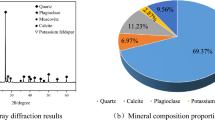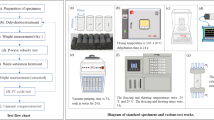Abstract
In the exploitation of deep geothermal resources, modeling and predicting deformation of surrounding rock after initial temperature damage is of great significance for preventing instability of underground structure. Hence, in this study, a series of cyclic loading/unloading creep experiments were carried out on sandstone samples including 7 kinds of initial temperature damage. It can be seen that under same stress level, loading, creep, unloading and recovery strain all arrive at the minimum value when damaging temperature is 500 ℃. Then, based on the proportion of the accelerating creep time and macro-creep failure characteristics, a newly creep failure tendency index \({f}_{\mathrm{ci}}\) was presented and it achieves the maximum value at 500 ℃ temperature damage, then 500 ℃ is regarded as a critical temperature status in transformation of creep failure mode, i.e., from tensile failure to shear failure. To describe the total creep deformation of sample including initial temperature damage, based on the given temperature-varying loading deformation modulus, viscosity parameters and relaxation time, by introducing Caputo fractional derivative comparing to relaxation time-dependent function, a fractional viscoelastic-damage creep model considering initial temperature damage was proposed. The validation of the proposed creep model was verified by creep experimental data of sample including initial temperature damage, and the effect of damaging temperature and fractional order on total creep deformation were revealed. Finally, a prediction of creep deformation was performed using the proposed fractional viscoelastic model in infinite time-scale, it is demonstrated that when loading stress exceeds to long-term strength of sample and loading time approaches infinity, creep failure is bound to occur and failure time can be predicted accurately.
Highlights
-
1.
Creep failure mechanism, mode and evaluation index of sandstone including different initial temperature damage was revealed and established based on the proportion of the accelerating creep time.
-
2.
A fractional time-varying viscoelasticity damage creep model considering initial temperature damage was proposed based on the relaxation time-dependent function.
-
3.
Creep failure time and deformation of rock material can be predicted by the proposed viscoelastic creep model under infinite loading time, which is based on mechanical parameters of creep failure stage.


















Similar content being viewed by others
Data Availability
The authors confirm that the data supporting the findings of this study are available within the paper.
References
Almeida R, Malinowska AB, Monteiro MT (2017) Fractional differential equations with a Caputo derivative with respect to a Kernel function and their applications. Math Methods Appl Sci 41(1):336–352
Bai MX, Reinicke KM, Teodoriu C, Fichter C (2012) Investigation on water–rock interaction under geothermal hot dry rock conditions with a novel testing method. J Petrol Sci Eng s 90–91:26–30
Bouras Y, Zorica D, Atanacković TM, Vrcelj Z (2018) A non-linear thermo-viscoelastic rheological model based on fractional derivatives for high temperature creep in concrete. Appl Math Model 55:551–568
Brantut N, Heap MJ, Meredith PG, Baud P (2013) Time-dependent cracking and brittle creep in crustal rocks: a review. J Struct Geol 52:17–43
Caselle C, Baud P, Kushnir ARL, Reuschlé T, Bonetto SMR (2022) Influence of water on deformation and failure of gypsum rock. J Struct Geol 163:104722
Franklin JA, Vogler UW, Szlavin J (1979) Suggested methods for determining water content, porosity, density, absorption and related properties and swelling and slake-durability index properties: part 1: suggested methods for determining water content, porosity, density, absorption and related properties. Int J Rock Mech Min Sci 16(2):143–151
Glover PWJ, Baud P, Darot M, Meredith PG, Boon SA, LeRavalec M, Zoussi S, Reuschle T (1995) α/β phase transition in quartz monitored using acoustic emission. Geophys J Int 120:775–782
Hu B, Yang SQ, Tian WL (2019) Creep-permeability behavior of sandstone considering thermal-damage. Geomech and Eng 18(1):71–83
Kim K, Kemeny J, Nickerson M (2014) Effect of rapid thermal cooling on mechanical rock properties. Rock Mech Rock Eng 47:2005–2019
Koeller RC (1984) Applications of fractional calculus to the theory of viscoelasticity. J Appl Mech 1(2):299–307
Liu DY, Xie LJ, Tuo XF, Long LJ (2017a) Creep properties of sandstone under different confining pressures and research on a nonlinear viscoelasto-plastic creep model. J Rock Mech Geotech Eng 36(S2):3705–3712 (In Chinese)
Liu QS, Qian ZC, Wu ZJ (2017b) Micro/macro physical and mechanical variation of red sandstone subjected to cyclic heating and cooling: an experimental study. B Eng Geol Environ 4:1–15
Liu XL, Li DJ, Han C, Shao YM (2021) A Caputo variable-order fractional damage creep model for sandstone considering effect of relaxation time. Acta Geotech 1–15. https://doi.org/10.1007/s11440-021-01230-9
Lund JW, Freeston DH, Boyd TL (2005) Direct application of geothermal energy: 2005 Worldwide review. Geothermics 34(6):691–727
Mainardi F (2010) Fractional calculus and waves in linear viscoelasticity: an introduction to mathematical models. World Scientific
Ren JL, Xue B, Zhang L, Liu W, Li D, Xu YS (2020) Characterization and prediction of rutting resistance of rock asphalt mixture under the coupling effect of water and high-temperature. Constr Build Mater 254:119316
Shao SS, Wasantha PLP, Ranjith PG, Chen BK (2014) Effect of cooling rate on the mechanical behavior of heated Strathbogie granite with different grain sizes. Int J Rock Mech Min Sci 70:381–387
Sterpi D, Gioda G (2009) Visco-plastic behavior around advancing tunnels in squeezing rock. Rock Mech Rock Eng 42(2):319–339
Sun HG, Chen W, Wei H, Chen Y (2011) A comparative study of constant-order and variable-order fractional models in characterizing memory property of systems. Eur Phys J Spec Top 193(1):185–192
Sweilam NH, Hasan MMA (2017) Numerical simulation for the variable-order fractional Schrdinger equation with the quantum Riesz-Feller derivative. Adv Appl Math Mech 9(04):990–1011
Vogel H (1921) The law of the relationship between viscosity of liquids and the temperature. Phys Z 22:645–646
Wu F, Chen J, Zou QL (2019) A nonlinear creep damage model for salt rock. Int J Damage Mech 28(5):758–771
Xia CC, Xu CB, Wang XD, Zhang CS (2009) Method for parameters determination with unified rheological mechanical model. J Rock Mech Eng 28(2):425–432 (In Chinese)
Xu WY, Yang SQ, Chu WJ (2006) Nonlinear viscoelastic-plastic rheological model (Hohai model) of rock and its engineering application. J Rock Mech Eng 25(3):433–447 (In Chinese)
Zhang WQ, Sun Q, Hao SQ, Geng JS, Lv C (2016) Experimental study on the variation of physical and mechanical properties of rock after high temperature treatment. Appl Therm Eng 98:1297–1304
Zhou HW, Wang CP, Han BB (2011) A creep constitutive model for salt rock based on fractional derivatives. Int J Rock Mech Min Sci 48(1):116–121
Zhu SY, Zhang WQ, Sun Q, Deng S, Geng JS, Li CM (2017) Thermally induced variation of primary wave velocity in granite from Yantai: experimental and modeling results. Int J Therm Sci 114:320–326
Acknowledgements
The work introduced in this paper was supported by the National Natural Science Foundation of China (41572334).
Author information
Authors and Affiliations
Corresponding author
Ethics declarations
Conflict of Interest
The authors declare that they have no known competing financial interests or personal relationships that could have appeared to influence the work reported in this paper.
Additional information
Publisher's Note
Springer Nature remains neutral with regard to jurisdictional claims in published maps and institutional affiliations.
Rights and permissions
Springer Nature or its licensor (e.g. a society or other partner) holds exclusive rights to this article under a publishing agreement with the author(s) or other rightsholder(s); author self-archiving of the accepted manuscript version of this article is solely governed by the terms of such publishing agreement and applicable law.
About this article
Cite this article
Liu, X., Li, D. & Li, C. Laboratory Testing and Modeling of Creep Deformation for Sandstone Including Initial Temperature Damage. Rock Mech Rock Eng 56, 2479–2495 (2023). https://doi.org/10.1007/s00603-022-03204-z
Received:
Accepted:
Published:
Issue Date:
DOI: https://doi.org/10.1007/s00603-022-03204-z




